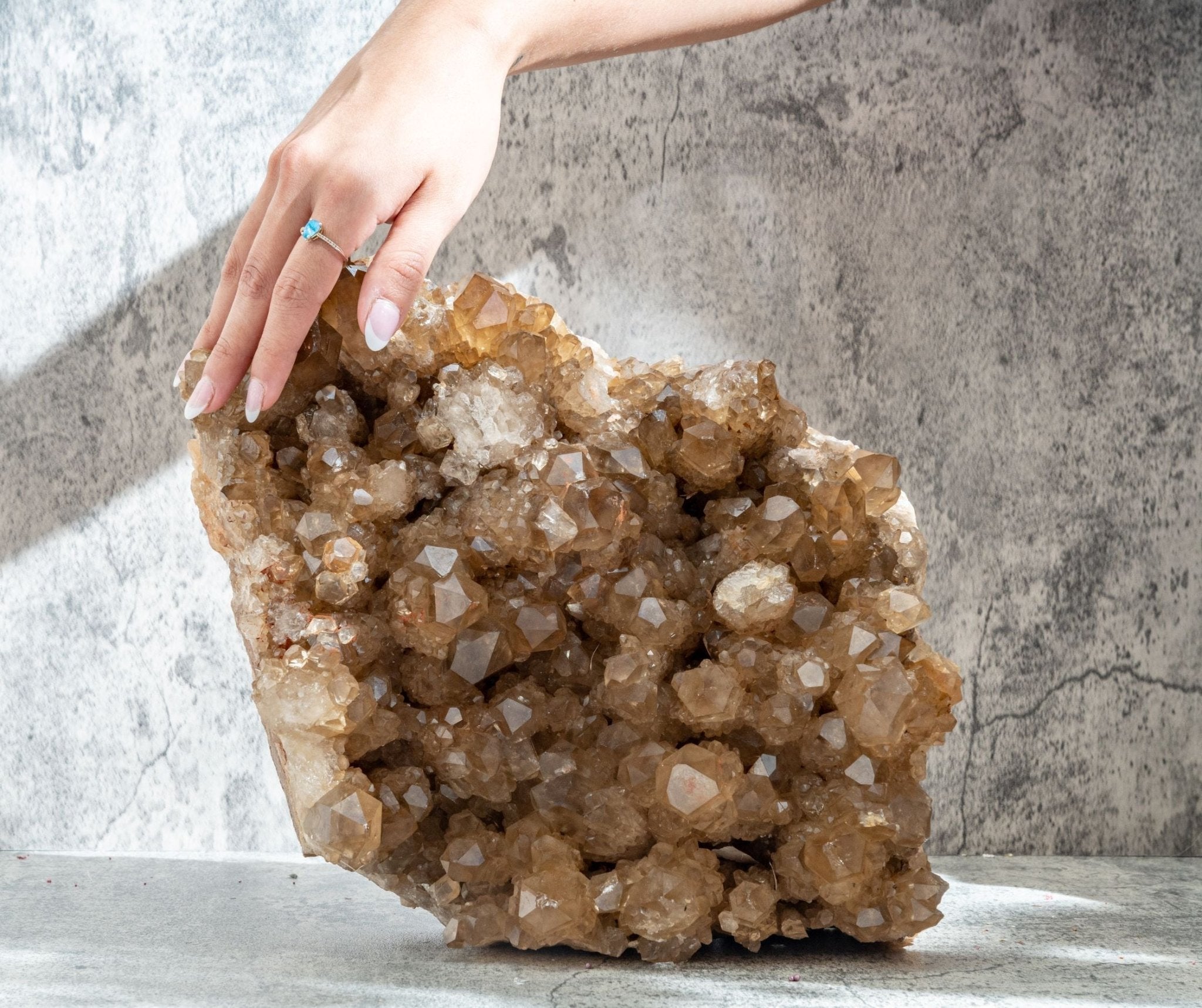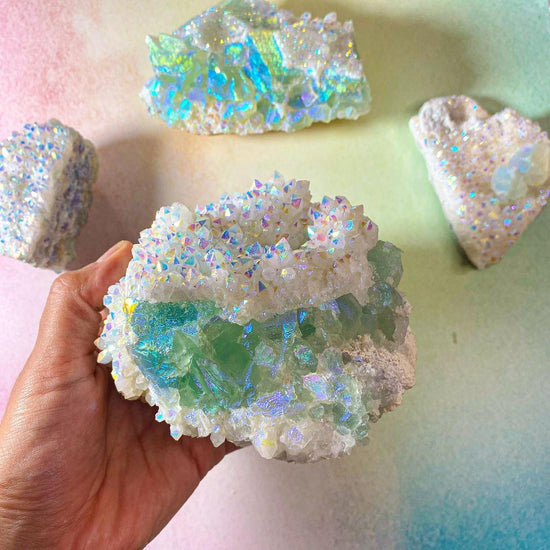Citrine is a popular crystal known for its ability to enhance confidence, manifesting abilities, motivation, creativity, and mental and emotional well-being. It is a powerful crystal that is often used for its ability to enhance confidence, manifesting abilities, motivation, creativity, and mental and emotional well-being. It is a form of quartz crystal that resonates with the solar plexus chakra, which is associated with personal power, self-esteem, and self-worth.
Citrine is often used to attract abundance and prosperity, making it a popular choice for those looking to improve their financial situation. It is also believed to be able to help with decision-making, which can be beneficial for those who struggle with making choices.
Additionally, citrine is known for its ability to negate negative energies and vibrations, such as anxiety, depression, fear, worry, and doubt. It is said to help cleanse and purify the aura and the environment, making it a great crystal to have in your home. However, it can be difficult to tell whether a citrine crystal is real or fake. In this article, we will discuss how to identify a genuine citrine crystal and the characteristics of a fake one.
What is Citrine Used For?
Citrine is a powerful crystal that is used to energize and recharge goals - financial and physical. It is also used to negate negative energies and vibrations such as anxiety, depression, fear, worry, and doubt. When working with authentic citrine, it can have a tremendous impact on one's life.
Signs of a Fake Citrine Crystal
1. Baked Amethyst Passed Off As Citrine

One of the most common fake citrines is baked Amethyst. Amethysts are powerful crystals, but they have a different energy than citrine.
The Baking Process
Selection: High-quality amethyst crystals are selected for the process. The quality of the amethyst will affect the final appearance of the faux citrine.
Cleaning: The amethyst is thoroughly cleaned to remove any impurities or external residues.
Preparation: The cleaned amethyst crystals are placed in a kiln, a specialized oven used for high-temperature processes.
Heating: The kiln is heated to temperatures between 878 to 1382°F (470 to 750°C). The exact temperature and duration depend on the desired color outcome.
Cooling: After reaching the desired color, the crystals are slowly cooled to room temperature to avoid any internal stress or fracturing.
Final Touch: The newly transformed crystals are polished and cut, ready to be marketed as citrine.
Why It's Done
The process is primarily done to produce a citrine look-alike at a fraction of the cost. These faux citrines are often sold in markets, sometimes without proper disclosure, misleading buyers into thinking they are purchasing genuine citrine.
How to Identify Baked Amethyst Passed Off as Citrine
Color Gradient: Genuine citrine usually has a uniform color, whereas baked amethyst may show a gradient from yellow to smoky or white.
Price: Faux citrine is generally cheaper than genuine citrine.
Inclusions: Genuine citrine may have unique inclusions, while baked amethyst-turned-citrine often lacks these.
Ethical Considerations
It's crucial for sellers to disclose that the citrine is actually baked amethyst to maintain ethical business practices.
Understanding this process can help consumers make informed decisions and appreciate the craftsmanship that goes into creating these beautiful, yet faux, gemstones.
2. Yellow Glass as Faux Citrine

natural inclusiosAnother way to tell if a citrine crystal is fake is by looking at its shape. Glass citrines are often made in molds, making them unnaturally perfect in shape with slightly rounded edges. They can look almost like hard plastic with very little variation in color patterns. There may even be internal cracking that occurred when setting the glass, along with potential gas bubbles.
Manufacturing Process
Material Selection: High-quality silica sand is the primary raw material used to make glass. Colorants, usually metal oxides, are added to achieve the yellow hue.
Melting: The raw materials are melted in a furnace at temperatures around 1700 to 2000°C (3100 to 3632°F).
Coloring: To mimic the color of citrine, specific metal oxides are added during the melting process. This gives the glass its characteristic yellow color.
Molding and Cooling: The molten glass is then shaped into gemstone-like forms using molds. It is then slowly cooled to room temperature to avoid internal stress.
Cutting and Polishing: Once cooled, the glass pieces are cut and polished to resemble citrine gemstones.
Why It's Done
Yellow glass is significantly cheaper to produce than sourcing genuine citrine. It offers a visually similar product at a fraction of the cost, making it attractive for budget-conscious consumers.
Identifying Yellow Glass Fakes
Refractive Index: Glass has a different refractive index than genuine citrine, which can be tested using gemological equipment.
Weight: Glass is generally heavier than quartz, so a faux citrine made from glass will weigh more than a genuine one of the same size.
Inclusions: Genuine citrine may have natural inclusions, while glass is usually flawless or may contain bubbles.
Price: If the price seems too good to be true, it probably is. Genuine citrine is more expensive than glass imitations.
Another subtle way to tell the difference is by feeling the temperature of the crystal. When holding a real citrine crystal in one hand and a fake in the other, the genuine crystal feels cooler than the glass, which is absorbing heat from your body.
A more obvious distinction of a fake citrine is remnants of purple from the Amethyst that can be spotted throughout or at the base of the crystal. Once baked, the Amethyst can become a bright, artificial-looking yellow. This varies greatly from the deep tones found in natural citrine.
Common Crystals Mistaken or Passed off for Citrine
There are several crystals that are often passed off as citrine but are not actually citrine. Some of the most common crystals that are mistaken for citrine include:
Smoky quartz: Smoky quartz is a dark brown or grayish-brown color, and it is often heat-treated to make it look like citrine. It is important to note that smoky quartz is not as yellow as citrine, and it does not have the same energy as citrine.

Topaz: Topaz can be treated to achieve a yellow color, but it is not as yellow as citrine, and it does not have the same energy as citrine. Topaz is a naturally occurring gemstone that can be found in a variety of colors, including yellow and golden hues similar to citrine.
How to Identify: Topaz is generally harder and has a higher refractive index than citrine. It's also usually more expensive.

Signature Real Citrine Characteristics
When it comes to signature features of authentic citrine, you'll notice rich, deep, and vibrant hues of smoky yellow, golds, and even cool-toned browns within a natural citrine cluster. Natural citrine will be slightly more expensive than heat-treated/fake citrine.
Real citrine generally will not have a pure white base. There will be color throughout. It may have smooth fault lines that usually run horizontally. And often no bubbles or infractions will be inside the crystal. In genuine citrine, this happens naturally in the earth over time. In heat-treated citrine, it happens in an oven.




Other ways to tell if a citrine crystal is genuine include:
Heat-treated citrine has large portions of white, and the color is concentrated at the top.
Sharp, white borders around the bottom of a druse or geodes are sure signs of heat-treated citrine. Citrine isn't found in geodes naturally.
Genuine citrine has a fairly uniform color from base to tip.
Genuine citrine is pretty clear inside even when raw, whereas, with heat-treated citrine, you cannot see through the crystal.
Genuine citrine generally has smooth, horizontal fault lines.
Heat-treated citrine is kind of crumbly since the oven process can cause damage to the crystal structure.
Determining the Value of a Real Citrine Crystal: Factors to Consider
The value of a real citrine crystal can vary greatly depending on several factors such as size, quality, and origin. Here are a few things to consider when determining the value of a citrine crystal:
Size: Generally, the larger the citrine crystal, the more valuable it is. However, it's also important to consider the quality of the crystal and how well it is formed.
Quality: The quality of a citrine crystal is determined by the color, clarity, and overall appearance of the crystal. A deep, rich yellow color is considered to be the most desirable and valuable.
Origin: Citrine crystals can be found in many locations around the world, and the origin of the crystal can affect its value. Some of the most well-known locations for citrine include Brazil, Madagascar, and Russia.

Here is an example of a high-quality raw and natural 53 lb citrine statement piece!
Based on these factors, the value of a real citrine crystal can range from a few dollars for a small, low-quality specimen to several thousand dollars for a large, high-quality specimen from a rare location.
It is also worth noting that certain citrine crystals with specific shapes, patterns or inclusions can be considered more valuable than others.
It's important to note that you can always ask a gemologist to examine the crystal and give you a more accurate assessment of its value.
At Amethyst Goddess, we understand the importance of sourcing high-quality, authentic crystals. That's why we take great care to inspect and verify each and every one of our crystals. We source the majority of our citrine crystals directly from Brazil, where the majority of genuine citrine crystals are found. Our team of experts carefully inspects each crystal to ensure that it is authentic and of the highest quality. We take pride in providing our customers with only the best crystals, so you can be confident that the citrine crystals you purchase from Amethyst Goddess are genuine and of the highest quality.
. it is important to be aware of the characteristics of a genuine citrine crystal to ensure you are working with an authentic one. By following these tips, you'll be able to spot a fake citrine a mile away.






Comment1
Thank you for sharing your knowledge about Crystal’s..